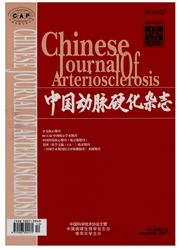

 中文摘要:
中文摘要:
目的探讨肱踝脉搏波传导速度对高血压前期人群进展至高血压的预测价值。方法对2004年12月至2012年12月每年定期到中南大学湘雅三医院健康管理中心体检的人群进行回顾性调查研究,分析期间出现的205例高血压前期人群的基线资料(包括肱踝脉搏波传导速度、一般情况、生化检测等)及其转归情况。结果至调查终止时,共54例发展为高血压,发展为高血压的比例达26.34%,中位随访时间长达5.89年;以基线肱踝脉搏波传导速度三分位数分组,高血压发生的累积风险从最低三分位数组到最高三分位数组依次升高,且组间差异具有统计学意义(P〈0.001);Cox回归分析显示,在校正基线年龄、性别、饮酒、教育、婚姻以及体质指数、肾小球滤过率、空腹血糖、总胆固醇、甘油三酯、高密度脂蛋白、低密度脂蛋白后,肱踝脉搏波传导速度仍是进展至高血压的独立危险因素,最大和中间三分位数组进展至高血压的风险分别是最低三分位数组的6.647(95%CI 2.374~18.616,P〈0.001)、3.008(95%CI 1.054~8.587,P=0.040)倍,基线肱踝脉搏波传导速度水平每增加100 cm/s,高血压前期人群进展至高血压的风险就增加22.3%(P=0.002)。结论肱踝脉搏波传导速度是高血压前期进展至高血压的独立危险因素,对高血压前期进展至高血压具有一定的预测价值。
 英文摘要:
英文摘要:
Aim To investigate the prognostic significance of brachial-ankle pulse wave velocity on the incidence of hypertension in prehypertensive population. Methods Data of the present retrospective survey were collected from the Health Management Center of the 3rd Xiangya Hospital from 2004. 12-2012. 12. The baseline characteristics and outcomes of 205 prehypertensive population from the data were analyzed. Results During a median follow-up of 5.89 years, 54 people (26. 34% ) developed into hypertension; According to the tertiles of baseline brachial-ankle pulse wave velocity values the cases were divided into three groups, the cumulative incidence of hypertension increased from the first tertile to the third tertile, and the differences between three groups were statistically significant( P 〈 0. 001 ) ; Cox regression analysis showed that brachial-ankle pulse wave velocity was an independent risk factor for hypertension in prehypertensive population after adjusting of baseline age, gender, drinking, education, marriage, body mass index, glomerular filtration rate, fasting plasma glucose, total cholesterol, triglycerides, high density lipoprotein, low density lipoprotein. The risk of development of established hypertension in those individuals with the third, second tertile of brachial-ankle pulse wave velocity at baseline were both higher than those with the lowest tertile of baseline brachial-ankle pulse wave velocity ( HR =6. 647,P 〈 0. 001 ; HR = 3. 008, P = 0. 040). In addition, baseline brachial-ankle pulse wave velocity values increased per 100 cm/s, the risk of development of established hypertension increased 22. 3% (P =0. 002). Conclusions The brachial-ankle pulse wave velocity is an independent risk factor of hypertension and might be used to predict the risk of de- velopment of established hypertension in prehypertensive population.
 同期刊论文项目
同期刊论文项目
 同项目期刊论文
同项目期刊论文
 期刊信息
期刊信息
